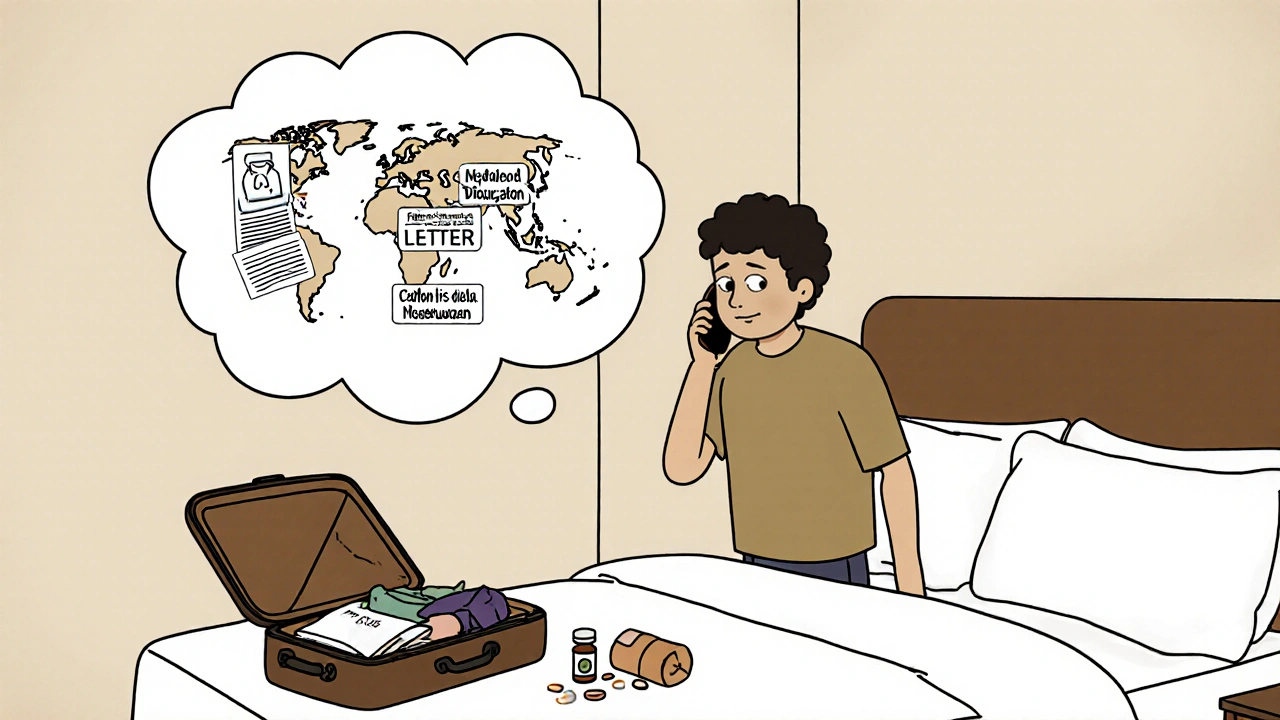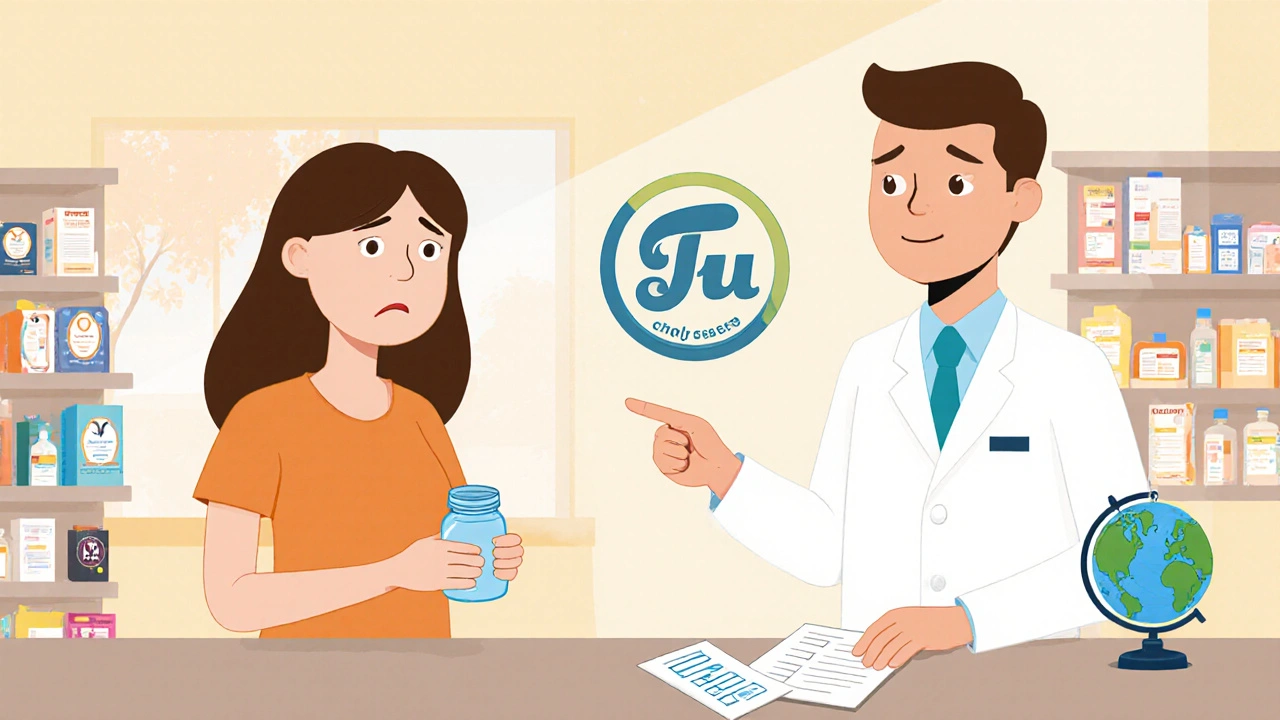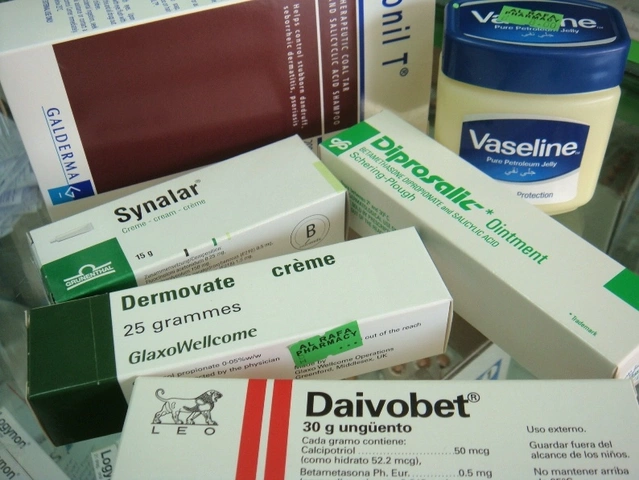If you’re traveling and suddenly realize your medications are gone-stolen from your bag, lost in transit, or left behind in a hotel-it’s not just an inconvenience. It’s a health emergency. Millions of travelers face this every year, and how you respond can make the difference between getting back on track and ending your trip early. The good news? There’s a clear, proven way to handle it. The bad news? Most people don’t prepare for it until it’s too late.
Don’t Panic. Do This First.
The moment you realize your meds are missing, stop. Breathe. Then act. The first thing you should do is contact your travel insurance provider. If you have comprehensive travel insurance, they likely have a 24/7 medical assistance line. Companies like Allianz, AIG, and Allianz Travel Insurance have teams stationed around the world who can connect you with local doctors, pharmacies, and hospitals. They’ve done this thousands of times. They know which clinics accept foreign prescriptions, which pharmacies carry generic equivalents, and which medications are even legal in that country.If you don’t have travel insurance, skip the panic and go straight to the next step: find a local pharmacy. Don’t try to buy over-the-counter substitutes. Many drugs that are available without a prescription abroad are controlled or banned in the U.S. and other countries. For example, codeine is sold freely in the UK but requires a prescription in the U.S. Pseudoephedrine, common in cold meds, is tightly restricted in Thailand. Buying the wrong thing can be dangerous-or illegal.
Get Your Documentation Ready
Before you even left home, you should’ve carried a letter from your doctor. If you didn’t, it’s not too late-but it’ll take longer. The letter needs to include:- Your full name and date of birth
- Your medical condition(s)
- The generic names of all your medications (not brand names)
- Dosage and frequency
- The prescribing doctor’s name, license number, and contact info
This letter is your lifeline. A 2023 study in the Journal of Travel Medicine found travelers with this letter replaced their meds 3.7 times faster than those without. Many foreign doctors won’t even consider writing a new prescription without it. The U.S. Department of State and the International Society of Travel Medicine both recommend this as standard practice. Print two copies. Keep one in your wallet. Leave one in your checked luggage.
Controlled Substances Are a Different Problem
If you take Adderall, Ritalin, OxyContin, Vicodin, or any other Schedule II controlled substance, you’re in a tougher spot. U.S. law doesn’t allow refills for these without a new prescription-even if you’re just out of pills. And most countries won’t honor a U.S. prescription for these drugs at all. The DEA and international drug control agencies treat these as high-risk substances.Here’s what you can do:
- Call your prescribing doctor immediately. Some may issue an emergency prescription that can be faxed to a local pharmacy if the country allows it.
- If your doctor can’t help, your travel insurance provider may arrange a telehealth consult with a U.S.-licensed physician. But even then, federal law (Ryan Haight Act) prohibits telehealth providers from prescribing controlled substances to patients abroad.
- Your only real option is to see a local doctor, explain your situation, and hope they’ll prescribe an equivalent. This is more likely in Europe or Canada than in Southeast Asia or Africa.
Bottom line: Never travel with only your last pill. Always carry extra, especially for controlled substances.
How to Find a Local Doctor Who Will Help
You can’t just walk into any pharmacy and ask for your meds. In 89% of countries, pharmacies are legally prohibited from filling foreign prescriptions. You need a local physician to write a new one.Here’s how to find one:
- If you have travel insurance, let them handle it. They’ll send you to a vetted provider.
- If you don’t, ask your hotel front desk for a recommended clinic. Tourist areas usually have English-speaking doctors who deal with travelers.
- Search for clinics affiliated with international hospitals or expat networks. Many cities have clinics specifically for foreigners.
- Use MedAire’s Global Health Response Team or similar services-they can call your home doctor, verify your history, and coordinate with local providers.
Most international doctors will want to see you in person before prescribing, especially for chronic conditions like diabetes, heart disease, or mental health meds. Don’t expect a quick script over the phone. Be prepared for a consultation fee-usually $50-$150.

Watch Out for Counterfeit Drugs
One of the biggest dangers isn’t not having your meds-it’s getting fake ones. The World Health Organization estimates that 1 in 10 medications sold globally are counterfeit. In parts of Southeast Asia and Africa, that number jumps to 30%. Fake pills can contain toxic chemicals, no active ingredient, or the wrong dose.How to avoid them:
- Only buy from licensed pharmacies. Look for official signs, uniforms, and pharmacy licenses displayed.
- Check the packaging. Authentic meds have consistent font, color, and seal. Counterfeits often have blurry printing or misspellings.
- Ask the pharmacist to show you the box from the supplier. Reputable pharmacies keep original packaging.
- If it looks too cheap, it probably is. A $5 version of a $100 brand-name drug is almost always fake.
The CDC’s 2024 Yellow Book warns that 31% of medication-related travel emergencies could be avoided with better pre-trip planning. That includes knowing where to get real meds-not just any meds.
What If Your Medication Is Lost on the Plane?
If your checked bag with your meds was delayed or lost by the airline, act fast. Airlines are required under IATA Resolution 701 to respond to baggage claims within 24 hours. Go straight to the airline’s baggage service desk. File a report. Ask if they can locate your bag or provide temporary assistance.Some airlines have partnerships with local pharmacies and can help you get a short-term supply while your bag is tracked. Keep your boarding pass and baggage claim ticket. You’ll need them for insurance claims later.
Prevention Is the Best Strategy
The easiest way to avoid this whole mess? Don’t let it happen.- Carry at least a 7-day supply of all meds in your carry-on. IATA reports 1 in 150 checked bags are mishandled. Don’t risk it.
- Keep meds in original containers with pharmacy labels. 63% of countries require this for entry.
- Use a digital app like Medisafe to store digital copies of your prescriptions and doctor’s letter. Even if your phone dies, you can show a printed QR code.
- For insulin or temperature-sensitive drugs, carry a small cooling pack. 41% of travelers report reduced effectiveness when meds are exposed to heat.
- Research your destination’s drug laws before you go. Some countries ban common U.S. meds. A quick search on the CDC’s travel site or your country’s foreign affairs page can save you weeks of trouble.

Costs and Insurance: What You Need to Know
Replacing meds abroad isn’t free. In Western Europe, expect to pay $75-$150 for a standard prescription. In Southeast Asia, it’s often $40-$90. Latin America runs $120-$200. If you’re uninsured, that’s out-of-pocket.Most comprehensive travel insurance plans cover prescription replacement up to $500-$1,000 per incident. Basic plans? Usually no. Check your policy before you leave. If you’re on a tight budget, consider adding medical assistance coverage-it’s often under $50 for a two-week trip.
And if your meds were stolen, file a police report. Airlines require it for baggage claims. Insurance companies require it for reimbursement. Don’t skip this step.
Real Talk: What Actually Works
Travelers in Western Europe have an 82% success rate replacing meds within 24 hours. In Southeast Asia? Only 54% make it within 48. Why? EU countries follow standardized pharmaceutical rules under Directive 2001/83/EC. The U.S. and EU systems are more compatible. In countries with less regulation, it’s a gamble.But here’s what consistently works:
- Travel insurance with medical assistance
- A printed doctor’s letter with generic names
- Carrying extra meds in your carry-on
- Not trying to buy meds from street vendors
One traveler in Bangkok lost her diabetes meds. She had her doctor’s letter, called her insurance, and was at a local clinic within three hours. The doctor prescribed the same insulin. She paid $60. She was back on track by dinner.
Another traveler in Mexico tried to buy Adderall off the street. He got a fake pill. He ended up in the ER. He didn’t have insurance. The bill was $3,200.
Preparation isn’t boring. It’s survival.
What If You Can’t Get Your Meds?
If, after all this, you still can’t get your medication-call your country’s embassy or consulate. They can’t give you pills, but they can help you find a doctor, translate documents, or contact your family back home to send you meds via courier (if legal). Some embassies have lists of local doctors who work with travelers.And if you’re dealing with a life-threatening condition like epilepsy, heart disease, or severe asthma? Don’t wait. Go to the nearest emergency room. They will stabilize you. You can sort out the prescription later.
Can I get my prescription refilled at a pharmacy abroad?
Generally, no. Most countries don’t allow pharmacies to fill foreign prescriptions. You’ll need to see a local doctor who can write a new prescription based on your documentation. Some EU countries are more flexible, but even there, a doctor’s letter is required.
What if I lost my pills and don’t have a doctor’s letter?
It’s harder, but not impossible. Contact your prescribing doctor via phone or email to get a letter sent to you. If that’s not possible, go to a local clinic and explain your situation. Bring any pill bottles, packaging, or photos of your prescription. Some doctors will still treat you based on your description, especially if you’re stable and honest about your condition.
Are generic drugs safe to use abroad?
Yes-if they’re from a licensed pharmacy. Generic drugs contain the same active ingredients as brand names. But in countries with weak regulation, counterfeit generics are common. Always check packaging, ask to see the supplier’s box, and avoid prices that seem too low. The active ingredient is what matters, not the brand.
Can I use telehealth to get a new prescription while abroad?
You can for non-controlled substances, but not for Schedule II drugs like Adderall or opioids. U.S. federal law prohibits telehealth providers from prescribing controlled substances to patients outside the country. Some services offer consultations and can guide you to local care, but they can’t legally issue those prescriptions.
How much extra medication should I pack?
Pack at least a 7-day extra supply in your carry-on. If your trip is longer than 30 days, aim for 14-30 days extra. Checked bags get lost or delayed. You can’t risk running out. For insulin or injectables, carry double your needs. Temperature changes can ruin them.
What if my medication isn’t available in the country I’m visiting?
Your doctor or travel insurance provider can help find an equivalent. For example, if your brand-name blood pressure med isn’t available, they may suggest a different ACE inhibitor or beta-blocker with the same effect. Never substitute without medical advice-even if it seems similar. Side effects and interactions vary.
Is travel insurance worth it for medication coverage?
Yes-if you take regular prescriptions. A $50 policy that covers $1,000 in replacement meds is a no-brainer. Without it, you could pay hundreds or thousands out of pocket. Basic plans often exclude this. Always check the fine print before you buy.







November 20, 2025 AT 12:40
Let’s be real-most people don’t even know what a generic name is, let alone carry a doctor’s letter. I’ve seen travelers in Bangkok try to buy Adderall from a street vendor because they ‘read it on Reddit.’ Dude, that’s not a pill, that’s a chemistry experiment gone wrong. And don’t even get me started on people who think ‘it’s just insulin’ and leave it in their checked bag. IATA says 1 in 150 bags get mishandled? That’s a 0.67% chance of disaster-and you’re gambling your life on it? Come on. Print two copies. Keep one in your wallet. Leave one in your checked luggage. And yes, I’m that guy who carries a laminated card with his meds and doctor’s info. You’re welcome.